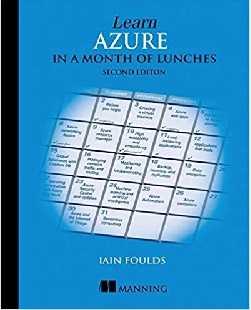| Learn Azure in a Month of Lunches, 2nd Ed |
Page 1 of 3 Author: Iain Foulds
This book, now in its second edition, aims to teach you Azure in around 20 hours, how does it fare? Businesses are increasingly moving applications to cloud infrastructure, owing to its many advantages (e.g. elastic scalability and reduced cost). Azure is a big player in cloud provisioning - so it makes sense for IT professionals to learn something about the technology underlying this change. The book is divided into 21 lessons, each of which should be achievable within a 1-hour lunchbreak. Some of the additional practical hand-on labs may take a short while longer. The book is targeted at the beginner, although some basic knowledge of Virtual Machines (VMs), networking, storage, website creation, and databases is assumed. The book is divided into 4 parts, namely:
Part 1 Azure Core Services The book opens with a brief overview of how easy it is to get your servers up-and-running, no more waiting for hardware, installation, configuration etc. You only pay for the resources you use, and temporarily getting ten times the resources is possible within minutes. These opening remarks drive a powerful case for using the cloud instead of on-premise servers. The author asks, “Is this book for you?”, and suggests if you’re an IT admin or developer, who wants to learn the core skills to create applications in the cloud – this is the book for you. It’s assumed you have a basic understanding of Virtual Machines (VMs), networking, storage, websites and databases – which might not be the case for many developers. The importance of performing the “try it now” and the hands-on lab exercises to reinforce the discussions is noted. The lab exercises use your own Azure account, Azure offers a free trial account for 30 days, and provides up to $200 (£150) of free credit. There’s a step-by-step walkthrough on how to create your free Azure account. The author next provides an overview of the Azure platform. Essentially it discusses the different models, namely:
These differing models provide for increasingly less control over your infrastructure, but this frees you to focus more effort on the parts needed to get your business done. Next, the author examines creating a virtual machine (VM), which lies at the heart of Azure, and increasingly companies are using VMs in preference to physical machines. Azure caters for both Windows and Linux. An Ubuntu Linux VM is created, and webserver software installed, in order to create a basic web application. This sounds easy in theory, however, there are less screenshots in this edition of the book, and Azure’s screens/text are known to change often, leading to Google searches if you encounter problems. The next chapter looks at Azure Web Apps, the idea here is that making use of PaaS, you only need to concentrate on deploying your application (rather than creating a VM, installing the web server software etc). This is a much easier process, and perhaps this chapter should have been given before the painstaking drudge of the previous chapter. Next, Azure storage is discussed, looking at the various types of storage available together with their advantages and costs. The section ends with a chapter on Networking basics, looking at the various virtual network components, before building a sample web application with secure traffic. While not the most exciting section in the book, it is necessary in order to gain a basic understanding of the core resources of Azure. Overall, this section is mostly easy to read, having good explanations and flow between sections, helpful diagrams, and useful website links for further information. A gentle degree of humour is given that assists the reading. Sometimes, the images/instructions in the book did not match those in Azure itself (the product gets updated regularly), which meant that following the practical exercises could get very frustrating. These traits apply to the whole of the book. |
||||
| Last Updated ( Tuesday, 09 March 2021 ) |

